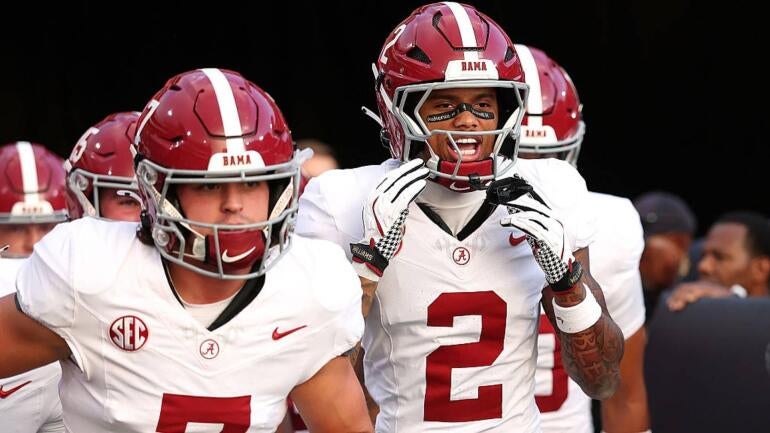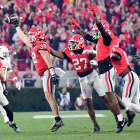College football conference tiebreakers: Sorting out scenarios for SEC, Big Ten, ACC, Big 12, American races
With a glut of teams still in conference title and College Football Playoff races, we're sorting through how each league will pick its title game representatives

Lacking clear frontrunners across several conference championship races entering November, it's time to sort out tiebreaker policies and various scenarios within the SEC, Big Ten, ACC, Big 12 and American. We're expecting the Power Four to take up 11 spots in the College Football Playoff's 12-team bracket, along with the American champion.
Conference expansion forced change for most tiebreaker policies in recent years, and we've included those here -- direct from various leagues:
Big Ten tiebreakers
The Big Ten race looks to be the simplest heading into the final month of the season. Ohio State and Indiana will meet in Indianapolis if both teams win out against manageable schedules. Michigan is the only team left the Buckeyes play with a winning record while the Hoosiers' lone opponent likely heading to a bowl game is Maryland.
Oregon and Iowa, each with one conference loss, play each other on Nov. 8, which will eliminate one from the championship game conversation. USC, also with one current loss in conference play to Illinois, also takes on the Ducks next month. Things would get sticky in the Big Ten if the Wolverines win out and beat Ohio State for a fifth consecutive season. Then, tiebreaker scenarios enter the chat with multiple one-loss teams in play.
The Big Ten announced its new tiebreaking procedures ahead of the 2024 season and will follow these guidelines next month.
- A. The tied teams will be compared based on head-to-head matchups during the regular season.
- B. The tied teams will be compared based on record against all common conference opponents.
- C. The tied teams will be compared based on record against common opponents with the best conference record and proceeding through the common conference opponents based on their order of finish within the conference standings. The tied teams will be compared based on the best cumulative conference winning percentage of all conference opponents.
- D. The representative will be chosen based on the highest ranking by SportSource Analytics (team Rating Score metric) following the regular season.
- E. The representative will be chosen by random draw among the tied teams conducted by the commissioner or designee.
SEC tiebreakers
There are currently six teams separated by one loss or fewer in the SEC, meaning the league's tiebreaker scenarios will likely come into play to decides which two squads play in Atlanta. The following procedures will be used, in order, to determine that game's entries:
- A. Head-to-head competition among the tied teams
- B. Record versus all common conference opponents among the tied teams
- C. Record against highest (best) placed common conference opponent in the conference standings, and proceeding through the conference standings among the tied teams
- D. Cumulative Conference winning percentage of all conference opponents among the tied teams
- E. Capped relative total scoring margin (see Appendix A) per SportSource Analytics versus all conference opponents among the tied teams
- F. Random draw of the tied teams
If a tiebreaker produces standings with two teams tied for first place in league play, they are both selected for the championship game. To decide the seeding of the two teams, they will progress through the two-team tiebreaker procedures, which determines the home and away designation for the SEC Championship Game.
In the event of a two-team tie for second place, the SEC will use the following procedure:
- A. Head-to-head competition among the two tied teams
- B. Record versus all common conference opponents among the two tied teams
- C. Record against highest (best) placed common conference opponent, proceeding through the Conference standings among the tied teams
- D. Cumulative conference winning percentage of all conference opponents among the tied teams
- E. Capped relative total scoring margin per SportSource Analytics versus all conference opponents among the tied teams
- F. Random draw of the tied teams
If there's a three-team tie for first place, those aforementioned steps will be used in descending order until two teams who stand alone are determined.
ACC tiebreakers
Georgia Tech and Virginia are the only teams with unblemished conference records entering November. They will meet in Charlotte at the end of the year if both out. However, Miami leads a group of five teams with one conference loss who are mathematically still alive.
According to the ACC's policy, if three or more teams are tied with the highest percentage of wins or two or more teams are tied with the second highest percentage of wins in league play, the following tiebreaker procedure goes into effect:
- A. For a two-team tie, head-to-head competition between the two tied teams.
- B. Win-percentage against all common opponents.
- C. Win-percentage against common opponents based upon their order of finish (overall conference win percentage with ties broken) and proceeding through other common opponents based upon their order of finish.
- D. Combined win-percentage of conference opponents.
- E. The tied team with the highest ranking by the Team Rating Score metric provided by SportSource Analytics following the conclusion of regular-season games.
- F. The participant shall be chosen by a draw as administered by the commissioner or commissioner's designee.
If three or more teams are tied atop the league standings, the following procedure will be used:
- A. Combined head-to-head win-percentage among the tied teams if all tied teams are common opponents.
- B. If all tied teams are not common opponents, the tied team that defeated each of the other tied teams.
- C. Win percentage against all common opponents.
- D. Win percentage against common opponents based upon their order of finish (overall conference win percentage, with ties broken) and proceeding through other common opponents based upon their order of finish.
- E. Combined win-percentage of conference opponents.
- F. The tied team with the highestranking by the Team Rating Score metric provided by SportSource Analytics following the conclusion of regular season games. G. The participant shall be chosen by a draw as administered by the Commissioner or Commissioner's designee.
Big 12 tiebreakers
The Big 12 race joins the SEC and ACC as chaotic coming down the stretch. Separated by a game in the league standings, BYU, Cincinnati, Texas Tech and Houston look like the four teams best-suited to challenge one another for two spots.
Here's the Big 12's tiebreaker procedure, enacted in 2024, that will be used in determining the two teams who play at AT&T Stadium in December in the event of a two-team tie for second:
- A. Head-to-head competition among the two tied teams.
- B. Win percentage against all common conference opponents among the tied teams.
- C. Win percentage against the next highest placed common opponent in the standings (based on the record in all games played within the conference), proceeding through the standings. When arriving at another group of tied teams while comparing records, use each team's win percentage against the collective tied teams as a group (prior to that group's own tie-breaking procedure) rather than the performance against individual tied teams.
- D. Combined win percentage in conference games of conference opponents (i.e., the strength of conference schedule).
- E. Total number of wins in a 12-game season. The following conditions will apply to the calculation of the total number of wins — only one win against a team from the FCS or lower division will be counted annually. Any games that are exempted from counting against the annual maximum number of football contests per NCAA rules shall not be included.
- F. Highest ranking by SportSource Analytics (team Rating Score metric) following the last weekend of regular-season games.
- G. Coin toss
If there are multi-team ties in the Big 12, which is a high-probability this season, the following procedure will be followed:
- A. The records of the three (or more) tied teams will be compared based on winning percentage in games among the tied teams — if all teams involved in the tie did not play each other, but one team defeated all other teams involved in the tie, the team that defeated all other teams in the tie is removed from the tiebreaker, and the remaining teams revert to the beginning of the applicable tiebreaker process (i.e., two team or three or more team tie). Also, if all teams involved in the tie did not play each other and no team defeated all other teams involved in the tie, move to the next step in tiebreaker.
- B. The records of the three (or more) tied teams will be compared based on winning percentage against all common conference opponents played by all other teams involved in the tie.
- C. Record of the three (or more) tied teams against the next highest placed common opponent in the standings (based on the record in all games played within the conference), proceeding through the standings. When arriving at another group of tied teams while comparing records, use each team's win percentage against the collective tied teams as a group (prior to that group's own tie-breaking procedure) rather than the performance against individual tied teams.
- D. Record of the three (or more) tied teams based on combined win percentage in conference games of conference opponents (i.e., strength of conference schedule)
- E. Total number of wins in a 12-game season. The following conditions will apply to the calculation of the total number of wins: Only one win against a team from the FCS or lower division will be counted.
American tiebreakers
There are seven teams separated by a single game in the American standings. Navy and Tulane are the lone unbeatens against conference competition. The tiebreaker policy in the American is a bit different from its Power Four counterparts. In the event of a multi-team tie, the following procedure will take effect:
- If there is no head-to-head result, and one of the tied teams was ranked in the latest available CFP Selection Committee rankings and doesn't lose in the final weekend of regular-season conference play, it will be declared a Championship Game participant.
- If there is no head-to-head result, and one of the tied teams was ranked in the latest available CFP Selection Committee rankings and loses in the final weekend of regular-season Conference play, then a composite average of selected computer metrics (Connolly SP+, SportSource TR116 SOR, ESPN SOR, KPI) will be used to determine the Championship Game participant.
- If there is no head-to-head result, and both tied teams are ranked in the latest available CFP Selection Committee rankings, the higher-ranked tied team that doesn't lose in the final weekend of the Conference regular season will be a Championship Game participant.
- If there is no head-to-head result, and neither of the tied ranked teams wins in the final weekend of the conference regular season, a composite average of selected computer metrics (Connolly SP+, SportSource TR116 SOR, ESPN SOR, KPI) after all games concludes the final weekend of the Conference regular season will be used to determine the Championship Game participant.
- If there is no head-to-head result, and neither of the tied teams is ranked in the latest available CFP Selection Committee rankings going into the final weekend of the conference regular season, a composite average of selected computer metrics (Connolly SP+, SportSource TR116 SOR, ESPN SOR, KPI) after all teams conclude the final weekend of the Conference regular season will be used to determine the Championship Game participant.
- If still tied, win percentage against all common conference opponents.
As noted, the CFP rankings are vital within the American's tiebreaker policy. The selection committee's first top 25 will be released on Nov. 4.


















